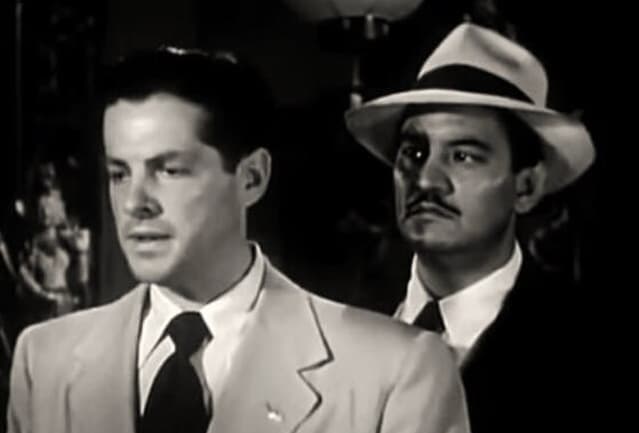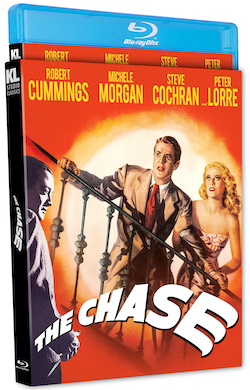Why, for Film Noir Fans, ‘The Chase’ Is Worth the Effort
Director Arthur Ripley proves adroit in his use of blocking and, especially, the deployment of mirrors. A sharp sense of displacement, both physical and psychological, filters through the movie.

While no one should go mistaking “The Chase” (1946) as an exemplar of film noir, anyone interested in the genre will likely find it worthwhile, if also notably cockeyed. Kino Lorber, which is releasing a Blu-ray of the movie, is pitching it as “something truly mind-bending and surreal” — basically a polite acknowledgment that the film is something less than the sum of its parts.
Still, it is “something” that imbues those parts with a distinctive weirdness. How true is “The Chase” to the Cornell Woolrich novel, “The Black Path of Fear,” on which it was based? Fans of classic American cinema will note that Woolrich authored “It Had To Be Murder,” the 1942 short story that inspired Alfred Hitchcock’s “Rear Window” (1954). The pathway to film from literature is rarely straightforward. “The Chase” is its own creature.
The reasons for that can’t help but be as numerous as a collaborative art form allows. The producer on the movie was Seymour Nebenzal, a German Jew who fled his home country in 1933 and worked with notable filmmakers like G.W. Pabst, Douglar Sirk, and Fritz Lang. The director of “The Chase,” Arthur Ripley, began his career as a writer for a comedy kingpin, Mack Sennett, and at one time had a close working relationship with Frank Capra.
How Ripley, who had made films with comedians Harry Langdon, Edgar Kennedy, and W.C. Fields, got a name for noir is a good question. “Voice on the Wind” (1944), starring a largely forgotten matinee idol, Frances Lederer, proved he could direct a serious film, and “The Chase” is more inventive than a mid-level production might lead you to believe. Ripley proved adroit in his use of blocking and, especially, the deployment of mirrors. A sharp sense of displacement, both physical and psychological, filters through the movie.

Then there’s Robert Cummings, an actor of affable, if somewhat indeterminate, affect who had a significant career, including on television: a sitcom, “The Bob Cummings Show,” ran for five seasons on, alternately, NBC and CBS. In “The Chase,” Cummings plays Chuck Scott, a World War II vet down on his luck. We first see him standing outside the window of a cafe. He’s eyeing a skillet full of pancakes and bacon, and hasn’t a penny to his name.
Fate intervenes when Bob stumbles over a wallet and uses part of its largesse to buy breakfast. Bob is an honest man: After digging out a business card from the wallet, he seeks out its owner. Upon arriving at the address, Bob is greeted warily, having to confront two personages — or, rather, their disassociated eyes — through the peephole in the front door. Movie fans will immediately recognize the voice belonging to the second eye as Peter Lorre. In noir terms, this bodes well.
Lorre plays Gino, the right-hand man for a ruthless gangster and, from all appearances, enthusiastic collector of antique statuary, Eddie Roman (Steve Cochran). When Chuck returns the wallet, Roman is bemused; when Chuck admits spending some of the money, Roman is taken aback. Anyone who is that much of a simp should be trustworthy, right? Roman hires Bob as his chauffeur and puts him to the test in a limousine that has been specially outfitted with a hidden gas pedal and brake in the rear of the car. Plot contrivance, anyone?
Less contrived and more important is Roman’s wife, Lorna. As portrayed by French actress Michèle Morgan, Mrs. Roman is the Hollywood ideal of womanly pulchritude — what with those cheekbones, blonde mane, and regal bearing. Maybe she’s too ideal: Lorna is a pro forma femme fatale. It’s hard to know if that was at the script’s insistence or because of Morgan’s facility with English. Whatever the case, Bob is roped into her orbit and the two attempt to escape the clutches of Roman and Gino, with dreams of life in exotic Havana.
What happens next is highly disappointing, as the film takes an out that is unwieldy and close to nonsensical. Through convolutions that aren’t worth spoiling, we learn that Bob suffers from “anxiety neurosis” — in contemporary terms, PTSD — and is prone to hallucinations. Except that these hallucinations are indicative less of Bob’s psyche than the desperation of screenwriter Philip Yordan to find something, anything, to tie together a lot of loose ends.
Ripley, to his credit, maintains a sense of momentum throughout and Cumming, forever the pro, gives his all to the effort. Lorre snarks around the proceedings in good form and cinematographer Frank F. Planer bestows it all with silky gradations of light. “The Chase” isn’t a must-see, but should you make time for it, the rewards outnumber its liabilities.

